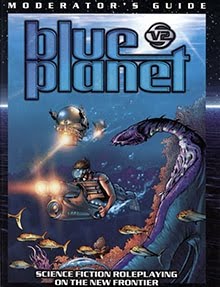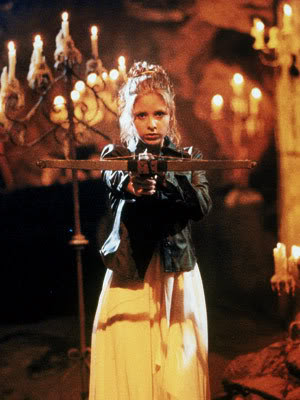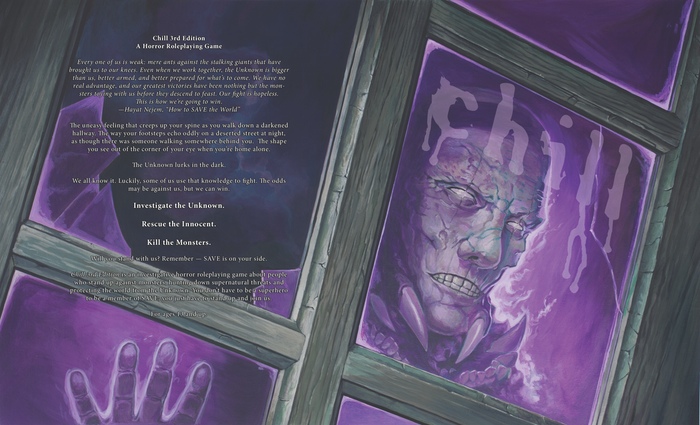Day 21 appears to be Favorite Setting here at #RPGaDAY2015, or so I think. I haven’t really been looking at the schedule.
So, favorite setting? I’m of two minds on that, but one’s a cheat: the modern world, but with a twist. It’s something that’s too overly-broad, but dangit, it’s fun to place the iPad on the table, open up Google Maps and say, “You’re right here.” Swipe to street view. “And this is what you see.”
I’m going to Blue Planet for my real answer.
Now, despite the flaws of the game itself — the unfocused skill list and lack of guidance for what to do in the setting, for starters — the setting is fantastic. Here’s the basics:
We find a wormhole to another planetary system, find a habitable world there and send settlers. However, bad things happen back home — a global blight nearly starves the planet — and we can’t afford to send a resupply mission. Generations pass and we’ve crawled back up from the ashes, and send a ship to the world we found a century ago. We expect to find the remains of the initial two thousand. We did not expect to find that they survived: they survived and flourished.
Then we found unobtanium on the new planet and suddenly a flood of immigration. It’s a gold rush — over the decade after Recontact, the population of the new planet goes from 75,000 to over two million.
Just that is a fine, fertile field to start a game in. Play as the Natives, resentful of the Abandonment, angry at the Earthers coming in and taking the land. Play as the eco-cops, trying to keep corporate marauders from laying waste to Poseidon, just as they did to the Earth. Play as a new arrival, grateful to have escaped the hellscapes of the Earth system, now trying to make their way on a paradise world.
Who is in the right here? Who has the right to this planet? Cases can be made for all sides, really.
 But that’s just one thing I like about the setting. There’s the oddness that the game is set up with all this history and — initially released around the time of your World of Darkness, your Shadowrun, your Deadlands — there was no metaplot designed to prompt people into buying supplement after supplement. “Here’s how the game world is set up in the now of 2199,” Blue Planet says. “Now go make it your own!” ((My “short” campaign wound down maybe two sessions before the actual end. I was going to end it with terrorists destroying the orbital station that transferred people to the planet.))
But that’s just one thing I like about the setting. There’s the oddness that the game is set up with all this history and — initially released around the time of your World of Darkness, your Shadowrun, your Deadlands — there was no metaplot designed to prompt people into buying supplement after supplement. “Here’s how the game world is set up in the now of 2199,” Blue Planet says. “Now go make it your own!” ((My “short” campaign wound down maybe two sessions before the actual end. I was going to end it with terrorists destroying the orbital station that transferred people to the planet.))
The third thing I really like about the setting is that make it your own philosophy. The major setting book of BPv2 looked at island clusters: a big map of one area with named cities, towns, and outposts. Following that, a listing of just some of the areas. In the Zion Islands, Kingston is given a full on writeup, New Fremantle is described in a few paragraphs, Pearl is given a bullet point, and Retreat is only a dot on the map. How much hand-holding do you want when creating your play space in Blue Planet? If you want a complete setting, grab First Colony and play in and around Haven. Want to make up your own place with some supporting material? Retreat is a nice town. ((..or is it? You choose.)) Or if you want to do all the heavy lifting, there are three more huge archipeligos that you can detail to your liking! Carve out your slice of paradise!
Man, such a fun setting. Ancient mysteries, current grudges, a boiling pot of hard science, transhumanistic cyberpunk on a world of water and islands and conflict and hard, driving rain…
I’d love to go back and explore.

 The two above are great games and are serious contenders for the top spot, but I have to give that to Eden Studio’s Buffy: The Vampire Slayer. The writing style (and overwrought trade dress) are perfect to drop the player right into the setting. The Cinematic version of Unisystem was developed for the action movie feel displayed in the show, much how the Heroic version of Cortex Plus was developed for Marvel, above. The terminology for skills – fighting with weapons was termed “Getting Medievalâ€, shooting was “Gun Fu†– echoed the Buffiness of the setting.
The two above are great games and are serious contenders for the top spot, but I have to give that to Eden Studio’s Buffy: The Vampire Slayer. The writing style (and overwrought trade dress) are perfect to drop the player right into the setting. The Cinematic version of Unisystem was developed for the action movie feel displayed in the show, much how the Heroic version of Cortex Plus was developed for Marvel, above. The terminology for skills – fighting with weapons was termed “Getting Medievalâ€, shooting was “Gun Fu†– echoed the Buffiness of the setting.
 In Lacuna, you’re basically travelling into the land that everyone travels to when they dream. You’re hunting down serial killers in this dreamland — the murderer has already been caught and is sleeping right next to you — where you can cleanse his or her personality. It’s heavily implied that your characters were psychopaths who had been cleansed in the exact same manner. It’s also implied that the organization behind this rehabilitation isn’t reliable.
In Lacuna, you’re basically travelling into the land that everyone travels to when they dream. You’re hunting down serial killers in this dreamland — the murderer has already been caught and is sleeping right next to you — where you can cleanse his or her personality. It’s heavily implied that your characters were psychopaths who had been cleansed in the exact same manner. It’s also implied that the organization behind this rehabilitation isn’t reliable.